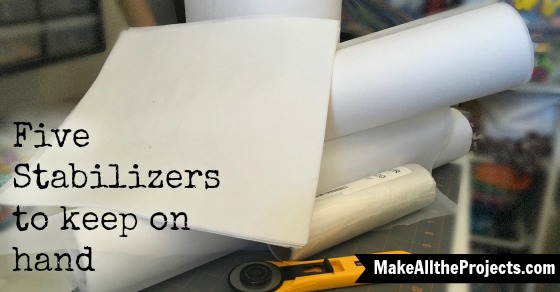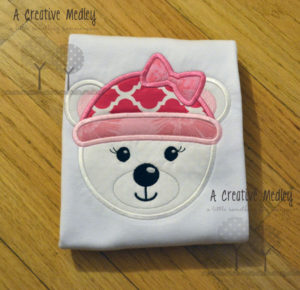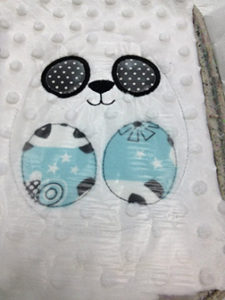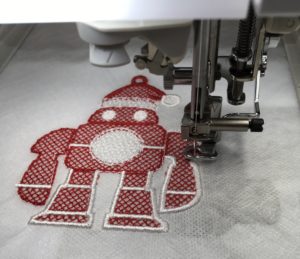You do not need to own every embroidery stabilizer on the market. Some have a very specific job and if you are not doing that job, you just don’t need it. I went through my Amazon order history to see which stabilizers I have ordered in the past. These are my favorites.

This post contains affiliate links
Tearaway Stabilizer
I love this tearaway stabilizer by Exquisite. I have to laugh a little at the name because it truly is exquisite. Felties are where I started digitizing and I have stitched literally thousands of them. These are designs stitched onto felt and then cut out. They have a million uses.
I tried so many different brands and weights of tearaway stabilizer and I always come back to this. I hate seeing stabilizer peeking out between the layers of a feltie, it just looks unfinished to me. This stabilizer pulls away nice and clean, leaving no shreds or “pokies” sticking out of the edges. It is equally clean on the back of towels and other project where the excess is torn away.
Cutaway Stabilizer
There are many different kinds of cutaway that may be useful for you, but I always keep a soft light weight cutaway on hand. It doesn’t create that stiff ugly outline on shirts and it is great for softies that have filled objects, like eyes or noses that would be too much for a tearaway to support. For super dense designs I can add another layer, but I rarely need to. Once again, Exquisite is my go to brand. It gives me consistently beautiful results and the price is right. I have found that I can use this on all but the lightest t-shirts without getting show-through, so I tend to use it more often than polymesh because (shhhh….) I’m cheap!

Polymesh Stabilizer
Technically this is a cutaway, but it deserves its own point. Polymesh is perfect for t-shirts and other lightweight fabrics where you do not want the stabilizer to show through. It drapes nicely with the fabric so that it won’t stand out or make your project stiff. I also use it on the back of towels when a tearaway won’t cut it, but I don’t want it to show any more than necessary.
One important thing to note is that polymesh is notorious for shrinking under heat. I have not had a problem with this particular brand, but I highly recommend testing a sample with your particular iron to see if you will need to pre-shrink it before using it.

 Water soluble TOPPER
Water soluble TOPPER
This is the one that you want when you are stitching projects that have a lot of texture, like a towel or minky. I use it on just about every single Peekaboo or other stuffed toy that I make. Depending on your machine, some people use this on t-shirts as well, to help lettering and appliques stand up nice and thick on top of your fabric. I have found that I need to use it on my single machine, but not on my multi-needle. Try it and if it makes a big difference, you will know and if it doesn’t, then you know that too! You just place this on top of your project and stitch, after you are finished pull off what you can and the rest can be removed with a dab of water. This is not technically a stabilizer, but is sold in the same section and I consider it part of my stabilizer collection. I go through a ton, so I buy it by the bolt.

 Water soluble STABILIZER
Water soluble STABILIZER
This is different than the topper, this is an actual stabilizer. There are lots of great brands out there, I have always used Vilene and it worked for me so I stuck with it. This is what you want to use to make Freestanding Lace. I don’t use it often, but it is great to have it on hand when the mood strikes. I also use it on the back of towels from time to time. That one is more of a judgement call – there are times when I want the back clean, but a tearaway just will not give the results I am looking for. It is important to remember that this will wash away, so while the back is clean, it is also no longer supporting the design. If you are using it in this way, do a test run and wash and dry a few times to make sure that your design stays beautiful. I have this Stitch and Rinse stabilizer on my list to try next time I make towels.

Each of these come in a variety of widths, so if the one I linked does not fit your hoop, just select the one that does. Remember that your stitch field is not the size of your hoop, so a 5 inch wide piece will not fit a 5×7 hoop. When in doubt, measure the outside of your hoop and add a bit to account for the fact that it gets pushed down between the two pieces of the hoop. It is far better to have it too big than too small. You can always cut it down, but if it is too small it is totally unusable. I go through a lot of stabilizer, so I tend to buy the biggest roll I can to save money. If you are more of an occasional hobbyist, you may prefer a smaller roll.
Options, options and more options
There are many many more stabilizers available – heat away, sticky tearaway, water activated sticky, pressure activated cutaway and many more. They each have a job and do it well.
But this should not be one of the options!
You’ll notice that I do not have Glad Press n Seal or dryer sheets on my list. I actually keep a box of Press N Seal in my sewing room but it is NOT as an embroidery stabilizer. I will admit, I used to. We still have a burp cloth that I made 12 years ago that has been used as a rag for many many years. It still crinkles when I pull it out of the dryer because that plastic wrap is still there. I got lucky, I never damaged my machine – although I’ll never know how much I shortened its lifespan.
In the meantime, I learned much more about what that plastic could be doing inside my machine and I cringe at that crinkly burp cloth. I know that embroidery is not a cheap hobby and I love to save money wherever I can, but stabilizers that are made for embroidery machines cost pennies per hooping and are engineered to support stitches and not harm our expensive machines. Buying in bulk or buying wide rolls and cutting them down to fit your hoop are great money savers that won’t risk your machine or your warranty. You can also add your favorites to your Amazon cart so that you will be notified when the price drops.
